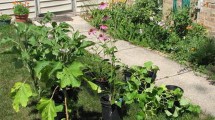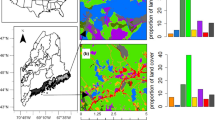Abstract
Anthropogenic changes of the environment influence the distribution and abundance of pollinators such as bumblebees and have been proposed as one of the main causes in their worldwide decline. In order to evaluate the impact of expanding anthropogenic landscapes on supporting pollinator potential, reliable tools are needed. Bombus terrestris is one of the most abundant bumblebee species in Europe, and these bumblebees are known as generalist pollinators of not only wild flowers in nature but also of crops in agriculture. For more than two decades, these bumblebees have been commercially mass reared for biological pollination in greenhouses. In this project, we placed commercial hives of the bumblebee B. terrestris containing one queen and 40 workers, in three different locations in the region of Ghent (Belgium), and the performance of these hives was followed during a 4-week period in spring 2012. In parallel, we determined the floral richness and diversity index in the chosen study sites. The sites consisted of a rich urban environment with patchy green areas opposed to an urban environment with poor landscape metrics; a third rural study site showed average positive landscape metrics. The results demonstrated that the hive biomass and numbers of workers increased significantly in the rich compared to the poor environment, providing a mechanism to discriminate between study sites. In addition, the bumblebee-collected pollen showed that the flowering plants Salix spp. and Rosaceae/Prunus spp. are dominant food sources in all anthropogenic environments during early spring. Finally, the results are discussed in relation to the optimization of the experimental setup and to the use of commercial bumblebee hives in assessing local pollinator support within any given environment.


Similar content being viewed by others
References
Banaszak-Cibicka, W., & Zmihorski, M. (2012). Wild bees along an urban gradient: winners and losers. Journal of Insect Conservation, 16(3), 331–343.
Beug, H. J. (2004). Leitfaden der Pollenbestimmung fur Mitteleuropa und Angrenzende Gebiete. Munich: Friedrich Pfeil.
Cameron, S. A., Lozier, J. D., Strange, J. P., Koch, J. B., Cordes, N., Solter, L. F., et al. (2011). Patterns of widespread decline in North American bumble bees. Proceedings of the National Academy of Sciences of the United States of America, 108(2), 662–667.
Duchateau, M. J., & Velthuis, H. H. W. (1988). Development and reproductive strategies in Bombus colonies. Behaviour, 107, 186–207.
Fuchs, R., & Muller, M. (2004). Pollination problems in Styrian oil pumpkin plants: can bumblebees be an alternative to honeybees? Phyton-Annales Rei Botanicae, 44(1), 155–165.
Gallai, N., Salles, J. M., Settele, J., & Vaissiere, B. E. (2009). Economic valuation of the vulnerability of world agriculture confronted with pollinator decline. Ecological Economics, 68(3), 810–821.
Ghazoul, J. (2005). Buzziness as usual? Questioning the global pollination crisis. Trends in Ecology & Evolution, 20(7), 367–373.
Girard, M., Chagnon, M., & Fournier, V. (2012). Pollen diversity collected by honey bees in the vicinity of Vaccinium spp. crops and its importance for colony development. Botany-Botanique, 90(7), 545–555.
Goka, K. (2010). Introduction to the special feature for ecological risk assessment of introduced bumblebees: status of the European bumblebee, Bombus terrestris, in Japan as a beneficial pollinator and an invasive alien species. Applied Entomology and Zoology, 45(1), 1–6.
Goulson, D. (2000). Are insects flower constant because they use search images to find flowers? Oikos, 88(3), 547–552.
Goulson, D. (2003). Effects of introduced bees on native ecosystems. Annual Review of Ecology, Evolution, and Systematics, 34, 1–26.
Goulson, D. (2010). Bumblebees: their behaviour, ecology and conservation. Oxford: Oxford University Press.
Goulson, D., Hanley, M. E., Darvill, B., & Ellis, J. S. (2006). Biotope associations and the decline of bumblebees (Bombus spp.). Journal of Insect Conservation, 10(2), 95–103.
Goulson, D., Hughes, W. H. O., Derwent, L. C., & Stout, J. C. (2002). Colony growth of the bumblebee, Bombus terrestris, in improved and conventional agricultural and suburban habitats. Oecolog. 130, 267–273.
Goulson, D., Lepais, O., O'Connor, S., Osborne, J. L., Sanderson, R. A., Cussans, J., et al. (2010). Effects of land use at a landscape scale on bumblebee nest density and survival. Journal of Applied Ecology, 47(6), 1207–1215.
Gruter, C., Moore, H., Firmin, N., Helantera, H., & Ratnieks, F. L. W. (2011). Flower constancy in honey bee workers (Apis mellifera) depends on ecologically realistic rewards. Journal of Experimental Biology, 214(8), 1397–1402.
Hennig, E. I., & Ghazoul, J. (2011). Plant-pollinator interactions within the urban environment. Perspectives in Plant Ecology Evolution and Systematics, 13(2), 137–150.
Knight, M. E., Martin, A. P., Bishop, S., Osborne, J. L., Hale, R. J., Sanderson, A., et al. (2005). An interspecific comparison of foraging range and nest density of four bumblebee (Bombus) species. Molecular Ecology, 14(6), 1811–1820.
Kremen, C., Williams, N. M., & Thorp, R. W. (2002). Crop pollination from native bees at risk from agricultural intensification. Proceedings of the National Academy of Sciences of the United States of America, 99(26), 16812–16816.
Lemmens, E., Oude Essink, H., Koel, H., Peters, H., Pluym, M., van der Post, H., et al. (2012). Drachtplanten- en bijengids. bijenhouden.nl, Online database: http://www.bijenhouden.nl/pagina/drachtplanten_zoek.asp.
Mattila, H. R., Sears, M. K., & Duan, J. J. (2005). Response of Danaus plexippus to pollen of two new Bt corn events via laboratory bioassay. Entomologia Experimentalis Et Applicata, 116(1), 31–41.
Mommaerts, V., Sterk, G., Hoffmann, L., & Smagghe, G. (2009). A laboratory evaluation to determine the compatibility of microbiological control agents with the pollinator Bombus terrestris. Pest Management Science, 65(9), 949–955.
Mommaerts, V., Reynders, S., Boulet, J., Besard, L., Sterk, G., & Smagghe, G. (2010). Risk assessment for side-effects of neonicotinoids against bumblebees with and without impairing foraging behavior. Ecotoxicology, 19(1), 207–215.
Peterson, R. K. D., Meyer, S. J., Wolf, A. T., Wolt, J. D., & Davis, P. M. (2006). Genetically engineered plants, endangered species, and risk: a temporal and spatial exposure assessment for Karner blue butterfly larvae and Bt maize pollen. Risk Analysis, 26(3), 845–858.
Potts, S. G., Biesmeijer, J. C., Kremen, C., Neumann, P., Schweiger, O., & Kunin, W. E. (2010). Global pollinator declines: trends, impacts and drivers. Trends in Ecology & Evolution, 25(6), 345–353.
Pywell, R. F., Warman, E. A., Hulmes, L., Hulmes, S., Nuttall, P., Sparks, T. H., et al. (2006). Effectiveness of new agri-environment schemes in providing foraging resources for bumblebees in intensively farmed landscapes. Biological Conservation, 129(2), 192–206.
Reille, M. (1998). Pollen et Spores d'Europe et d'Afrique du Nord: Supplement 2. Marseille: Laboratoire de Botanique Historique et Palynologie.
Schneider, C. A., Rasband, W. S., & Eliceiri, K. W. (2012). NIH Image to ImageJ: 25 years of image analysis. Nature Methods, 9(7), 671–675.
Szabo, N. D., Colla, S. R., Wagner, D. L., Gall, L. F., & Kerr, J. T. (2012). Do pathogen spillover, pesticide use, or habitat loss explain recent North American bumblebee declines? Conservation Letters, 5(3), 232–239.
United Nations. (2012). World urbanization prospects, the 2011 revision: highlights. New York: Population Division, Department of Economic and Social Affairs, United Nations.
Van der Ham, R. W. J. M., Kaas, J. D., Kerkvliet, J. D., & Neve, A. (1999). Pollenanalyse, Stuifmeelonderzoek van Honing voor Imkers, Scholen en Laboratoria: Stichting Landelijk Proefbedrijf voor Insektenbestuiving en Bijenhouderij Ambrosiushoeve.
van der Steen, J. J. M. (2001). Review of the methods to determine the hazard and toxicity of pesticides to bumblebees. Apidologie, 32(5), 399–406.
van der Steen, J. J. M., de Kraker, J., & Grotenhuis, T. (2012). Spatial and temporal variation of metal concentrations in adult honeybees (Apis mellifera L.). Environmental Monitoring and Assessment, 184(7), 4119–4126.
Van Geert, A. (2010). Habitat fragmentation in farmland: genetic diversity, pollen flow and genetic incompatibility of Primula vulgaris. Brussels: Brussels University Press.
Velthuis, H. H. W., & van Doorn, A. (2006). A century of advances in bumblebee domestication and the economic and environmental aspects of its commercialization for pollination. Apidologie, 37(4), 421–451.
Verboven, H. A. F., Brys, R., & Hermy, M. (2012). Sex in the city: reproductive success of Digitalis purpurea in a gradient from urban to rural sites. Landscape and Urban Planning, 106(2), 158–164.
Walther-Hellwig, K., & Frankl, R. (2000). Foraging distances of Bombus muscorum, Bombus lapidarius, and Bombus terrestris (Hymenoptera, Apidae). Journal of Insect Behavior, 13(2), 239–246.
Whitehorn, P. R., O'Connor, S., Wackers, F. L., & Goulson, D. (2012). Neonicotinoid pesticide reduces bumble bee colony growth and queen production. Science, 336(6079), 351–352.
Winfree, R., Aguilar, R., Vazquez, D. P., LeBuhn, G., & Aizen, M. A. (2009). A meta-analysis of bees' responses to anthropogenic disturbance. Ecology, 90(8), 2068–2076.
Wojcik, V. A., & McBride, J. R. (2012). Common factors influence bee foraging in urban and wildland landscapes. Urban Ecosystems, 15(3), 581–598.
Acknowledgments
The authors thank Dr. Mark Brown (School of Biological Sciences, Royal Holloway, University of London, UK) for the careful editing of this manuscript and acknowledge the gifts of bumblebees by Biobest (Westerlo, Belgium). This study was supported by the Fund for Scientific Research Flanders (FWO-Vlaanderen).
Author information
Authors and Affiliations
Corresponding author
Additional information
Laurian Parmentier and Ivan Meeus are equal first authors.
Electronic supplementary material
Below is the link to the electronic supplementary material.
Supplem. Fig. 1
Photo of the placement of the five bumblebee hives in the centre of the 465 study sites 1. 2 and 3. All hives contained one queen and 40 workers at the start of the 466 experiment. and were placed in polystyrene multi-hive-boxes (80 x 35 x 25 cm) each with 467 room for a maximum of 3 hives. During the experiment. the multi-hive-boxes were covered 468 with a black plastic for reasons of insulation and protection against rain. All hives were placed 469 with their entrance to the East. (JPEG 189 kb)
Rights and permissions
About this article
Cite this article
Parmentier, L., Meeus, I., Cheroutre, L. et al. Commercial bumblebee hives to assess an anthropogenic environment for pollinator support: a case study in the region of Ghent (Belgium). Environ Monit Assess 186, 2357–2367 (2014). https://doi.org/10.1007/s10661-013-3543-2
Received:
Accepted:
Published:
Issue Date:
DOI: https://doi.org/10.1007/s10661-013-3543-2




